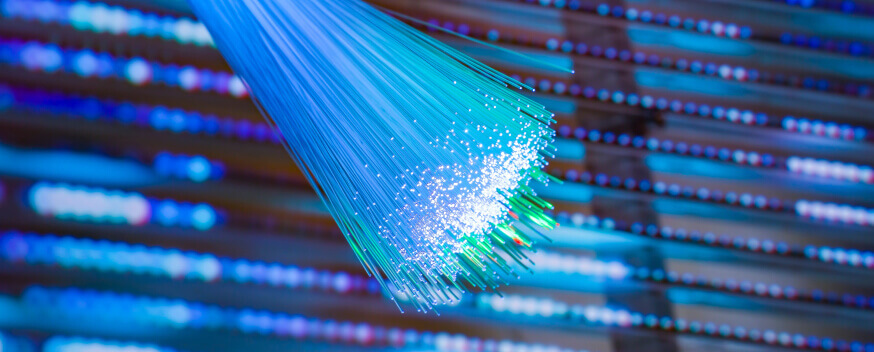You’ve probably heard the buzz about fiber internet. Teachers, remote workers, gamers, presidents, and CEOs are all talking about fiber. In all walks of life, people know that fiber internet is going to change our digital world forever.
Fiber gives you a whole new level of superfast internet, far above the speed of all previous internet types. Even better, fiber often costs less than other internet connections.
Internet service providers are rushing to build fiber infrastructure as fast as they can. If you’re lucky, you may already have more than one choice for fiber internet in your neighborhood.
In this article, we will explore the best fiber internet providers of 2025. We’ll also show you why fiber internet is a game-changer, and how to choose the best fiber internet plan for your needs.

What is Fiber Internet?
Fiber internet transmits data using light signals that travel through thin glass or plastic fibers. These fibers are bundled to create fiber-optic lines that deliver internet connections to homes and businesses.
Fiber internet offers unprecedented internet speed and data capacity. If you have fiber internet, you will get much faster uploads, downloads, and streaming compared to older internet technologies like DSL or cable. And fiber internet will prepare you for a near future of even more digital innovations that will need massive bandwidth.
PROS
CONS
Benefits of Fiber Internet
Internet at Lightspeed
Fiber internet sends data at unbelievably fast speeds. It’s not quite the full speed of light, but even 69% of lightspeed is still lightning-fast! At that speed, you can circle the earth five times in one second[1][2]. Downloading large files, streaming HD or 4K videos, and online gaming become seamless experiences.
Reliable Performance
Fiber internet is immune to signal interference from electromagnetic sources, unlike most other internet types. In other words, your microwave or your neighbor’s router will not disrupt your internet connection. Fiber internet also does not experience weather-related disruption from storms, which can be an issue for satellite internet and fixed wireless internet.
Symmetrical Speeds
Unlike other types of internet connections, fiber internet provides equally fast upload and download speeds. We can’t overstate how important this advance is. There’s a major difference between getting a speed called “200 Mbps” from cable internet or from fiber internet. You will get 200 Mbps download speed from both, but you will often get only about 10-15 Mbps upload from cable internet. Fiber will instead give you the full 200 Mbps for your upload speed. Symmetrical speeds are crucial for activities like video conferencing, cloud backups, and large file uploads with graphics or video.
Future-Forward Fiber Technology
Fiber-optic internet supplies the huge bandwidth needed by emerging technologies like virtual reality, augmented reality, and the Internet of Things (IoT). As the internet continues to develop and offer new opportunities, everyone will eventually want fiber in order to keep up with the necessary speeds.

Top Fiber Internet Providers
Top fiber internet providers fall into two major groups. The first group includes leading national companies such as AT&T Fiber and Frontier Fiber. The second group is a handful of smaller fiber providers that do more local and regional business. We’ve made a list of the top fiber internet providers of 2025 based on pricing, speed, data caps, contracts, coverage, and customer service.
When you have the option of fiber internet, you will usually find it superior to your other internet technology options. So, if any of the ISPs below is the only fiber internet provider in your area, it’s always a good idea to go with fiber service.
One more important note as you review fiber providers. Be aware that a number of these ISPs offer DSL or cable in addition to their fiber service. If your goal is to get all-fiber service, remember to look carefully at the plans that are available at your specific home address to make sure you are getting a fiber plan.
Top Fiber Internet Providers
It’s hard to go wrong with the performance of fiber internet. Fiber is going to beat all its competitors for speed and reliability, including cable, DSL, satellite, and fixed wireless. So, if you don’t yet have AT&T Fiber in your area, you’ll still get great internet access with one of these national or regional fiber providers.
How to Choose the Best Fiber Internet Provider
Availability
It’s simple but unavoidable that you can only get fiber internet if the infrastructure has reached your area. Type in your zip code to see which options may be available. And if you don’t have fiber access yet, keep checking in for updates!
Speed and Packages
Look at our detailed information on speed options and packages offered by each provider. Consider your internet activities and choose a plan that suits your needs. Most important are these two questions: 1) How many devices will be using the internet at once? 2) How many of those devices will be streaming, videoconferencing or gaming? You will need greater speeds if you have more devices streaming at once.
Reliability
Consider the provider’s reputation for reliability and customer satisfaction. Read customer reviews and our staff ratings to gauge the quality of their service.
Pricing
Compare the pricing of different providers and consider any additional fees or contract requirements.
Customer Support
Look for a provider that offers excellent customer support, including prompt technical help when needed. Providers with friendly, knowledgeable support reps in billing and ordering will also make your life much easier.

But How Does Fiber Internet Work, Really?
If you like to get a deeper dive on how tech wizardry works, here’s a little more detail for you. Fiber internet works by converting data into light signals and transmitting those signals through fiber-optic cables. But where does the light come from, and how does a light signal in fiber turn into words on your screen?
- When you send a request or access a website, your device transforms the information into data packets, which are small units of data that travel well over a network.
- Optical transmitters then convert those data packets to light signals using lasers or LEDs. The light signals travel through the fiber-optic cables.
- At the destination, optical receivers convert the light signals back into electrical signals so your digital device can show you the requested information.
What to Expect from Your Fiber Internet Installation
Once you’ve chosen your fiber plan, you will be ready for installation and activation. Fiber internet installation will vary depending on whether fiber lines already run all the way to your home. If there is not yet a fiber-optic line to your wall, installation may involve the following steps:
- Site Survey: A technician visits your location to assess the feasibility of installing fiber optic cables and determines the best routing options.
- Fiber Cable Installation: The technician installs the fiber optic cables either by aerial installation (on utility poles) or underground burial.
- Optical Network Terminal (ONT) Installation: The ONT, a device that connects your home network to the fiber optic cable, is installed. It may be placed inside or outside your premises.
- Connection Setup: The technician connects the ONT to your router or directly to your devices, ensuring proper configuration and testing.
Summary: Fiber Internet Connection vs. Other Internet Connections
Here’s a reference list of all the improvements you can expect with your fiber internet service.
Speed: Fiber internet offers the fastest speeds among all consumer-grade internet options, much faster than DSL internet, cable internet, satellite internet, and fixed wireless internet connections.
Reliability: Fiber internet is highly reliable and less prone to disruptions caused by weather conditions (satellite or wireless) or network congestion (cable).
Stable Connection: Fiber optic cables are resistant to interference, providing a stable and consistent internet connection. That’s a big departure from cable internet.
Low Latency: Fiber internet offers low latency, reducing delays during online gaming, video conferencing, or real-time communication. Satellite internet, fixed wireless internet, and DSL are all known to suffer from high latency under some conditions.
Multiple Device Support: Fiber internet can support multiple devices simultaneously without glitches, freezing, or slow speeds.
Symmetrical Speeds: Unlike any other form of internet connection, fiber internet provides symmetrical upload and download speeds. As more and more people begin to need to upload video or use videoconferencing, having a fast upload speed is crucial.
Can I Get Fiber Internet in My Area?
Not everybody has fiber internet access yet. A 2022 study found that 43% of U.S. households had access to fiber[6]. While that number has certainly risen since then with the rapid pace of fiber expansion, we won’t reach universal fiber access for years. Still, a majority of residents of cities and towns are likely to get fiber internet options within the next five years. Every month, there’s a new announcement of fiber buildout progress from many of these top fiber internet providers of 2025.
Even the federal government has recognized the need for equal access to high-speed internet. The Rural Digital Opportunity Fund dedicates over $20 billion to assisting buildouts in rural areas[7]. A great deal of that buildout will be fiber. And federal BEAD funding will add more investment to that pot[8].
Conclusion: Fiber Internet for the Future
Fiber internet is revolutionizing what we can do in our digital world. In addition to greatly improving your internet performance now, fiber-optic internet will prepare you for the future. You will be able to use any new technology that needs a lot of bandwidth and speed. VR and AR are just two of those technologies, but many more innovations will come in the next ten years that will need the power of fiber internet.
Frequently Asked Questions
Fiber internet pricing varies among providers and depends on the speed and package you choose. At the moment, average first-tier plans tend to start around $50/month, though some promotions will get as low as $30 for the first six months to a year. Check out
detailed provider plans for your zip code here at CompareInternet.com to get all the most current information you need.
Our site will show you whether fiber internet is available yet in your area when you enter your zip code. But if it isn’t, keep watching! Lots of top ISPs are building new fiber connections so quickly that if you don’t have fiber access today, you may get it next month!
Fiber internet requires specific equipment such as an ONT and may not be compatible with your existing modem or router. Many fiber providers now include equipment with your monthly plan fee at no extra charge.
Fiber internet is considered more secure than other types of connections because it is very difficult to physically hack into fiber-optic lines. Copper cables are much easier to tap.
Sources
[2] NASA. “How Fast is The Speed of Light?”
[3] Fierce Telecom. “AT&T says its fiber build is pricier than expected.”
[4] Fierce Telecom. “Windstream hit 300K new passings in 2022.”
[5] J.D. Power 2022 U.S. Residential Internet Service Provider Satisfaction Study
[6] Fierce Telecom: “FBA Report: 43% of U.S. Households Now Have Access to Fiber”
[7] Rural Digital Opportunity Fund
[8] Pew Trusts. “What States Need to Know About Federal BEAD Funding.”
